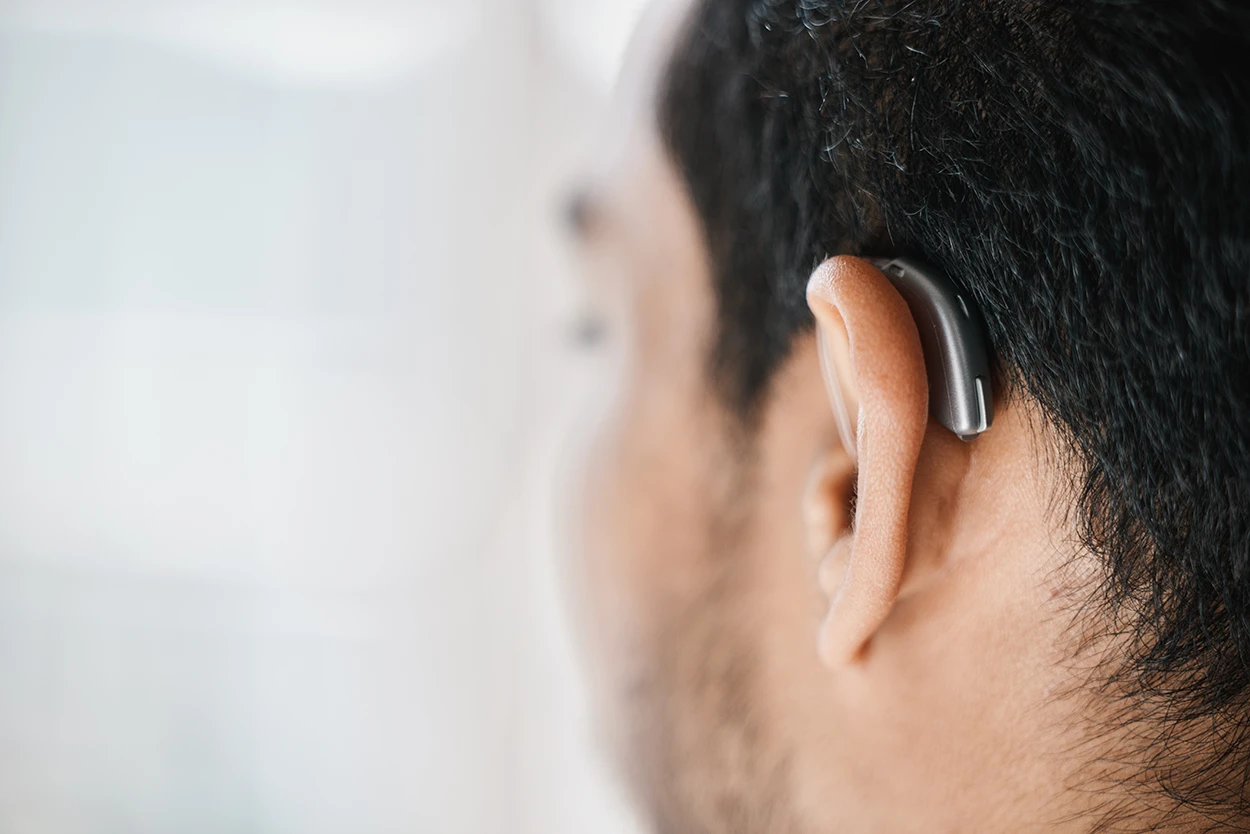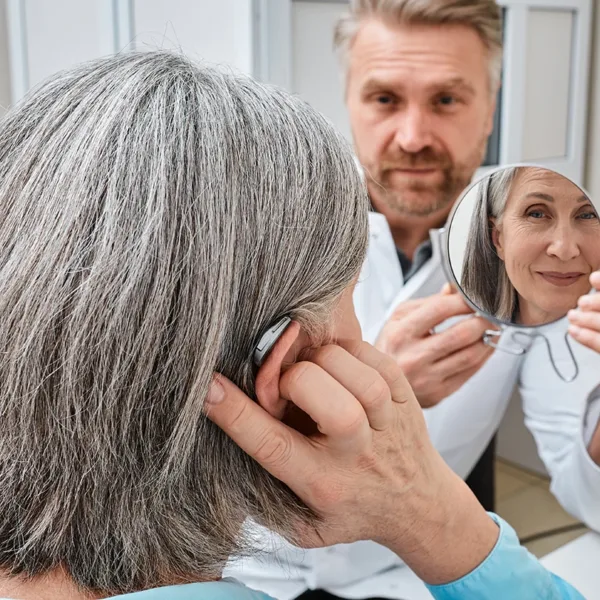
Factors That Influence Hearing Aid Effectiveness
Today’s hearing aids are incredibly powerful tools that deliver life-changing benefits for people with hearing loss. But as with any electronic device, they aren’t immune to wear and tear, and various factors can affect how well they perform over time. That said, it’s not always the device itself that’s the issue.
If you’ve ever wondered whether your hearing aids are losing their effectiveness, you’re in the right place. In this article, we explore factors that influence hearing aid effectiveness and share practical tips for maximizing device performance long-term.
The Average Hearing Aid Lifespan
Like any piece of technology, hearing aids can wear out over time. No device can last forever, but with proper care, hearing aids should last up to 3 to 7 years. The average hearing aid lifespan will vary based on the type and style of device you have.
Below is a table of average hearing aid lifespans based on style:
| Hearing Aid Style | Average Lifespan (years) |
|---|---|
| Behind-the-Ear (BTE) | 5 to 7 |
| In-the-Ear (ITE) | 3 to 5 |
| In-the-Canal (ITC) | 3 |
| Completely-in-Canal (CIC) | 3 |
It’s important to remember that these are just averages. Other factors like your cleaning routine, maintenance needs, and more can have a major impact on the lifespan and performance of your hearing aids.
Factors That Affect Hearing Aid Performance
While even the most advanced and durable hearing aids can last for years, no device is immune to everyday wear and tear. A variety of factors can influence how well they work after years of daily use. Some factors have to do with the natural weathering of the device itself, while others are related to maintenance needs or changes in your lifestyle.
By understanding what can impact performance, you can be better prepared to recognize issues early on and take steps to keep your devices working their best. Below are some of the most common reasons hearing aids may seem less effective, and what you can do about them:
Everyday Wear and Tear
Like any device you use daily, hearing aids naturally experience wear and tear over time. Small components like microphones, speakers, and receiver wires are constantly exposed to your skin oils, earwax, hair products, moisture, and other environmental contaminants. Even with mindful cleaning and care, these factors can gradually begin to affect performance.
While this doesn’t mean your hearing aids are “failing,” it does mean they need occasional servicing, part replacements, and adjustments to keep them working at their best. Regular cleaning, safe storage, and professional maintenance can go a long way in slowing the effects of everyday wear and tear.
Battery and Power Issues
If your hearing aid battery isn’t providing consistent power, you may notice weak amplification, distorted sound, or your device shutting off unexpectedly.
On average, disposable hearing aid batteries last about 3 to 10 days, depending on size and usage. With proper care, rechargeable hearing aids should give you anywhere from 20 to 30 hours of charge. The longest-lasting rechargeable hearing aid battery is exclusive to Audibel AI devices, lasting up to 51 hours on a single charge.
It’s important to remember that how you use your hearing aids can greatly impact how long your batteries last. Long periods of wireless streaming of phone calls, music, or TV audio drain power more quickly than everyday listening.
Storing your hearing aids properly, cleaning and dehumidifying them daily, and routine clean and check appointments with your specialist help preserve the lifespan of both your batteries and your devices.
Hearing Loss Progression
Sometimes, it’s not the hearing aid that has become less effective—it’s your hearing that has changed. Hearing loss can progress gradually, which means the settings that once worked perfectly may no longer provide the same clarity. You might notice speech sounding muffled, background noise feeling louder, or certain tones becoming harder to hear.
This is a sign that your devices may need to be reprogrammed or adjusted to match your current hearing needs. This is why regular hearing tests are so important. By keeping your prescription up to date, you can ensure that your hearing aids are calibrated correctly and continue to deliver the best possible performance for your unique hearing needs.
Cleaning and Maintenance
Today’s hearing aids are incredibly durable, but every electronic device needs proper cleaning and maintenance to function properly. Daily use exposes hearing aids to earwax, sweat, skin oils, dust, and moisture. All of which can interfere with microphones and speakers if not cleaned regularly.
Even a small amount of buildup can cause sound to become weak, distorted, or completely blocked. Proper cleaning and storage are simple habits that can make a big difference in how well your devices perform over time.
By maintaining a consistent cleaning routine and scheduling professional maintenance when needed, you can extend the lifespan of your devices and ensure they continue delivering clear, reliable sound.
Moisture Build-Up
Moisture is one of the most common (and preventable) causes of hearing aid performance issues. Even more advanced, waterproof hearing aid models still require routine care to keep them in tip-top shape.
Everyday activities like exercising, spending time outdoors, or even living in a humid climate can introduce sweat and condensation into the tiny components of your devices. Over time, this buildup can lead to muffled sound, static, or intermittent function, and in more serious cases, it can damage sensitive electronics.
Storing your hearing aids in a drying box or dehumidifier overnight, removing them before swimming or showering, and wiping them down every day can all minimize moisture-related problems.
Lifestyle or Environment Changes
As your daily routine evolves, so might your hearing needs. Moving to a busier city, starting a new job, or joining a social club can put you in new listening situations with different noise levels than you’re used to. Even small changes like spending extra time outdoors, going to the movie theater more often, or finding a new favorite restaurant can impact how effectively your hearing aids perform.
These lifestyle shifts may require updated programming and new specialized listening modes. Checking in with your hearing specialist ensures your hearing aids remain up to date and programmed to provide maximum performance in every environment you frequent.
Skipping Clean and Check Appointments
Even with careful at-home care, hearing aids require professional cleaning and maintenance. Most people benefit from attending a clean and check appointment every 3 to 4 months.
During these quarterly appointments, your hearing care provider can deep clean your devices, replace worn wax guards or tubing, and test the electronics to make sure everything is working as it should. These small tune-ups not only extend the life of your devices but also keep them performing at their peak.
When these visits are skipped, minor things can go unnoticed until they become much bigger issues. What could have been a simple fix becomes a larger repair or even grounds for replacement. Making professional clean and check appointments part of your hearing healthcare routine is one of the easiest ways to ensure your hearing aids remain effective and reliable for years to come.
We Service All Hearing Aid Brands—Find an Audibel Clinic Near You
Hearing aids are powerful tools that can dramatically improve your quality of life. Like any technology, various factors can affect how well they perform over time. The good news is that many issues are preventable or easily corrected with proper care, regular cleaning, and professional maintenance.
Don’t wait until small issues become bigger problems. Audibel hearing aid clinics service all hearing aid brands, no matter where you bought them. We are proud to have over 1,000 certified locations nationwide.
Find an Audibel clinic near you and schedule an appointment today.






Have a question or Comment?